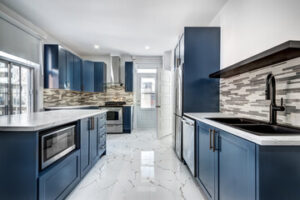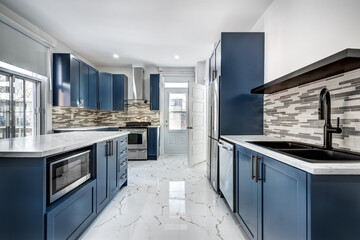Kitchen Remodeling is noisy and messy work. It is best to offload most of the planning and supervision responsibilities to Kitchen Remodeling Tacoma WA. A well-designed kitchen will provide a custom “home” for everything, making keeping your new space clean easy. Avoid over-customizing your kitchen, which can limit its appeal to future homebuyers.
 The design phase of a kitchen remodel starts long before the remodeling work begins. A professional designer can help you make the best choices for your space and help you set a realistic budget.
The design phase of a kitchen remodel starts long before the remodeling work begins. A professional designer can help you make the best choices for your space and help you set a realistic budget.
A good kitchen remodel will address your family’s needs and lifestyle and should also reflect your aesthetic. Your design elements can make a huge difference in the outcome. From glossy backsplashes in playful designs to eye-catching drawer handles and sink faucets, you can find many ways to add personal touches to your kitchen.
Another important part of the design process is determining whether you need a major or minor kitchen remodel. A major kitchen remodel is typically more extensive than a simple cosmetic update and may include gutting your entire kitchen and rebuilding it from scratch. Depending on the extent of the work required, a major kitchen remodel can cost close to $100K.
Once you’ve decided on a layout, it’s time to select materials and finishes. You’ll want to consider the durability, maintenance, and cost of different materials. For example, tin panels, recycled glass, and engineered wood can create a stylish, modern look, while tile flooring and a concrete countertop can provide a durable, low-maintenance option.
It’s also important to think about how the kitchen will be used in the future. For example, if you plan to entertain guests often, a large island with seating will be essential. However, if you plan to use the kitchen mostly as a workspace, a smaller island with a microwave and dishwasher may be more practical for your daily routine. Finally, be careful not to over-customize your kitchen. Adding features that are hard to replicate in other homes can limit your appeal to future buyers and limit the resale value of your home.
Layout
One of the most important parts of a kitchen remodel is the layout. There are many different ways to arrange cabinets and appliances, depending on your personal preference and the size of your kitchen. However, there are some layouts that are more effective than others. For example, the work triangle is a great way to ensure that all three main cooking areas are within reach.
Another popular layout is the L-shaped kitchen. This layout is great for small spaces because it makes the most of narrow rooms. It also allows two cooks to work in the same space at the same time. The L-shaped kitchen is also ideal for large spaces because it gives the cook space on all three sides of the room.
Lastly, there is the single wall kitchen. This kitchen layout has cabinets and appliances arranged along a single wall. This is a great option for small spaces because it allows you to fit more storage into the space. However, it is important to consider the location of your sink and refrigerator when using this layout. You want to make sure that they are not too far apart, otherwise, it can be difficult to get things out of the fridge.
Lastly, you should consider whether or not you want to include an island in your kitchen. If you do, then you should make sure that it is located close to your sink and stove, but not so close that it interferes with the working area. You also want to make sure that it is easy to get to your fridge and pantry, and that it does not block the door openings when open.
Materials
When it comes to kitchen remodeling, the materials used in your new kitchen will influence how the room looks and feels. There is a lot to consider, from the type of wood for your cabinets to the color and style of your backsplash. Using high-quality materials will ensure that your remodel lasts for a long time and adds value to your home.
Start with your big-picture goal: do you want more space, a better layout or just a fresh coat of paint? Once you have a clear idea of what you’re looking for, you can move on to smaller details, like choosing knobs that match your new countertops or dividers for the drawers in your brand-new kitchen cabinets.
Choose durable materials that can withstand the wear and tear of your busy kitchen. For example, a granite countertop will provide a beautiful look, but it’s also expensive and requires periodic sealing. On the other hand, a laminate countertop is inexpensive and requires little maintenance.
Think about how the colors in your kitchen will affect your mood and personality. Do you want blue’s cool, calming emotions or red’s attention-grabbing luster? The right choice will make your kitchen a place where you’ll love to cook and hang out with family and friends.
If you’re unsure of how to design your kitchen, a professional kitchen designer can help. They can guide you on material selection, create drawings and sample boards, and source the products you need. Moreover, they can give you tips on how to get the best value for your money and how to avoid overspending. They can also help you find the right contractor for your project.
Appliances
If your kitchen appliances are old or outdated, replacing them is a great way to give the room a fresh new look. But it’s important to remember that appliances do not make a kitchen—they are merely tools to help you prepare and cook your meals. That’s why choosing the right appliances is such a critical part of the remodeling process.
While it’s tempting to splurge on high-end appliances that you’ll use rarely, the best value is often found in more basic models that are designed for daily use. For example, the average sink and faucet center is used ten to thirty times per day—far more than any other kitchen “appliance.” ROHL has responded with a line of thoughtful sink/faucet/accessories solutions that offer a wide range of style and function.
The refrigerator, oven and sink make up the kitchen work triangle that maximizes convenience during meal prep. Choosing the right appliances first means that cabinetry and other surfaces can be designed around them, creating a cohesive aesthetic.
It’s also important to consider future homebuyers when choosing a customized appliance suite. Over-customizing a kitchen may limit its appeal to a smaller audience, so it’s best to avoid selecting custom items like walk-in wine cellars that could become dated quickly. Instead, choose features and design styles that are likely to be appreciated by a wide variety of buyers.
Lighting
The lighting in a kitchen is often overlooked as a secondary detail when it comes to renovations, but the quality and intensity of your fixtures can have a big impact on your space’s atmosphere. By using a variety of different fixture types, you can create a layered look that adds depth and style to the room.
There are two primary types of lighting for kitchens: ambient and directional. Ambient lighting can be achieved with ceiling lights or natural light from windows during the day, while directional lighting is best used on work areas, like countertops and sinks. For example, pendant lights above an island can provide both accent and task lighting, while recessed lights on the ceiling can be a great way to brighten up dark corners of your kitchen.
When it comes to decorative lighting, there are many options to choose from, including a wide range of shapes and colors. You can also use dimmable bulbs to control the brightness and add a pop of color. Another option is to add dimmable switches to your kitchen so you can change the mood as needed.
If you’re looking for a more modern touch to your kitchen, consider adding new gadgets like smart taps or smart trash cans. These can be controlled by your voice, making them a convenient addition to any kitchen design.
Visiting kitchen showrooms and home improvement stores is an excellent way to observe how various styles of appliances, cabinets, layouts, and lighting can fit together and complement one another. You can also find inspiration by attending neighborhood home tours or browsing design websites. These resources can help you determine which styles of remodeling will best suit your needs and budget.

